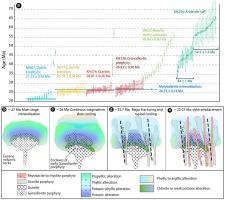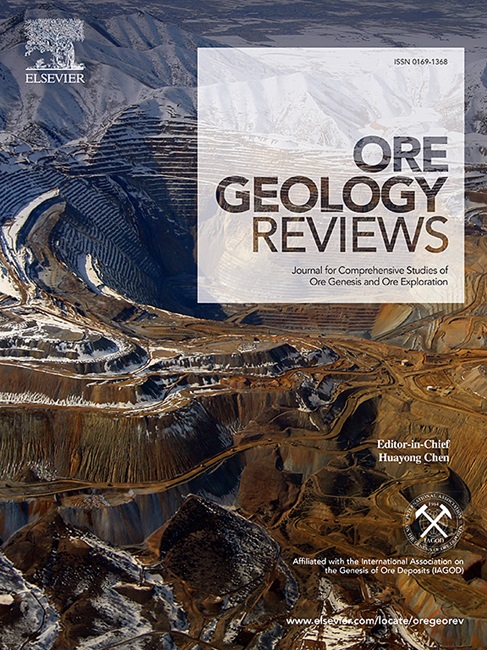Formation and degradation of a porphyry occurrence: The oligocene Khatoon-Abad porphyry Mo-Cu system, NW Iran
IF 3.2
2区 地球科学
Q1 GEOLOGY
引用次数: 0
Abstract
This study investigates the temporal relationships between mineralization and magmatism in the Khatoon-Abad porphyry Mo-Cu prospect (Urumieh-Dokhtar Magmatic Arc, NW Iran). Integrated zircon U-Pb and molybdenite Re-Os dating document a prolonged stationary magmatism, spanning ∼ 45 Myr (from ∼ 66 to ∼ 21 Ma; Paleocene-Early Miocene). Three main Oligocene ore-bearing granitic intrusions and an early Miocene barren dyke swarm are documented, with the main mineralization formed at ∼ 27 Ma, as attested by the molybdenite Re-Os age of 26.75 ± 0.14 Ma and the zircon U-Pb age 26.93 ± 0.30 Ma from the host granodiorite porphyry. Despite having similar geochemical fingerprints, including an adakitic signature and having REE patterns similar to productive magmas, the subsequent Oligocene granite bodies (∼26.0–25.7 Ma) yielded lower Mo-Cu enrichments and the early Miocene rhyodacite dykes (∼21 Ma) are barren. This evidence demonstrates that the efficiency of mineralization has been reduced by changes in the physiochemical conditions of magmatic-hydrothermal systems over time. We suggest that a perturbed geothermal gradient during later Oligocene granite (at ∼ 26 Ma) caused slow cooling/degassing of the melts, and hence determined an inefficient mineralization environment. We also infer that during the latest granite porphyry pulse (∼25.7 Ma), the structurally-controlled emplacement at shallower levels resulted in rapid melt cooling along with more meteoric water mixing, eventually minor potassic but vast phyllic alterations, and hence, causing a dispersed mineralization rather than a focused fluid flow. Therefore, the later Oligocene and early Miocene magmatic pulses degraded the early mineralization. The results of this study emphasize that a consistent magma supply into the chamber followed by a rapid magma-fluid flux to the mineralization site are needed for efficient mineralization in collisional settings. Otherwise, multiple mineralization pathways and sites would result in low-grade ore bodies.

斑岩矿床的形成与退化:伊朗西北部少全新统 Khatoon-Abad 斑岩钼铜系统
本研究调查了 Khatoon-Abad 斑岩钼铜矿探矿区(伊朗西北部乌鲁米耶-多赫塔尔岩浆弧)矿化与岩浆活动之间的时间关系。综合锆石 U-Pb 和辉钼矿 Re-Os 测定记录了一个漫长的静止岩浆活动,时间跨度达 45 Myr(从 66 Ma 到 21 Ma;古新世-早中新世)。记录了三个主要的渐新世含矿花岗岩侵入体和一个早中新世贫瘠堤群,主要矿化形成于 ∼ 27 Ma,这可以从主控花岗闪长岩斑岩的辉钼矿 Re-Os 年龄 26.75 ± 0.14 Ma 和锆石 U-Pb 年龄 26.93 ± 0.30 Ma 得到证明。尽管具有类似的地球化学特征,包括阿达克特特征,并具有与高产岩浆相似的 REE 模式,但随后的渐新世花岗岩体(∼26.0-25.7 Ma)的 Mo-Cu 富集度较低,而早中新世流纹岩堤(∼21 Ma)则贫瘠。这些证据表明,随着时间的推移,岩浆-热液系统理化条件的变化降低了成矿效率。我们认为,在晚渐新世花岗岩时期(26 Ma ∼),地热梯度的扰动导致熔体冷却/脱气缓慢,从而决定了成矿环境的低效率。我们还推断,在最近一次花岗斑岩脉冲期间(25.7Ma∼),结构控制下的较浅层位赋存导致熔体快速冷却,同时更多的陨石水混合,最终产生了轻微的钾质变化,但却产生了巨大的植物变化,因此造成了分散的成矿作用,而不是集中的流体流动。因此,渐新世晚期和中新世早期的岩浆脉冲使早期矿化退化。这项研究的结果强调,在碰撞环境中,需要有持续的岩浆供应进入腔室,然后岩浆流体快速流向成矿部位,才能实现高效成矿。否则,多种成矿途径和地点将导致低品位矿体。
本文章由计算机程序翻译,如有差异,请以英文原文为准。
求助全文
约1分钟内获得全文
求助全文
来源期刊

Ore Geology Reviews
地学-地质学
CiteScore
6.50
自引率
27.30%
发文量
546
审稿时长
22.9 weeks
期刊介绍:
Ore Geology Reviews aims to familiarize all earth scientists with recent advances in a number of interconnected disciplines related to the study of, and search for, ore deposits. The reviews range from brief to longer contributions, but the journal preferentially publishes manuscripts that fill the niche between the commonly shorter journal articles and the comprehensive book coverages, and thus has a special appeal to many authors and readers.
 求助内容:
求助内容: 应助结果提醒方式:
应助结果提醒方式:


